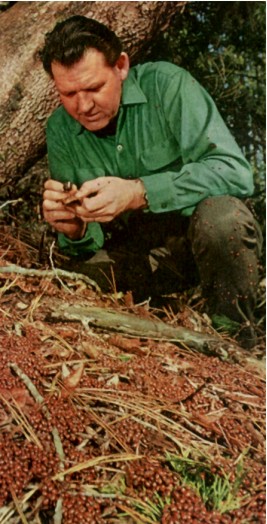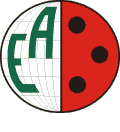Ecology of Aphidophaga
International symposia on the research into behaviour and ecology of aphidophagous insects
Kenneth Sverre H a g e n
(1919-1997)
 Ken Hagen, professor emeritus of
Entomology at the University of
California, Berkeley, died suddenly of a ruptured aortic aneurism on 10
January 1997. He was born in Oakland, California on 26 November
1919. His parents were from Norway, and his father was a seaman. Ken
attended Fremont High School in Oakland, where he graduated in 1938
and then enrolled in San Francisco State College. He received there his
A.A. degree in 1942. Ken then attended U.C. Berkeley, where he earned
his B.S. in entomology in 1943. He then went to Officer Candidate
School at Columbia University, where he was commissioned in the
U.S.Navy. On a brief leave he married his fiancee, Maxine White, on 1
December 1943. A week later he went to Norfolk, Virginia to attend
Amphibious Training School, and then was shipped out to Europe. During
the war he served on the USS Anne Arundel, as a lieutenant in
charge of a landing craft section, and saw action in the Neptune
Invasion
at Omaha Beach in Normandy, and the Dragon Invasion in the south of
France in 1944. In 1945, he participated in the landings at Okinawa,
where the fierce fighting stranded his boat on the beach overnight.
Ken Hagen, professor emeritus of
Entomology at the University of
California, Berkeley, died suddenly of a ruptured aortic aneurism on 10
January 1997. He was born in Oakland, California on 26 November
1919. His parents were from Norway, and his father was a seaman. Ken
attended Fremont High School in Oakland, where he graduated in 1938
and then enrolled in San Francisco State College. He received there his
A.A. degree in 1942. Ken then attended U.C. Berkeley, where he earned
his B.S. in entomology in 1943. He then went to Officer Candidate
School at Columbia University, where he was commissioned in the
U.S.Navy. On a brief leave he married his fiancee, Maxine White, on 1
December 1943. A week later he went to Norfolk, Virginia to attend
Amphibious Training School, and then was shipped out to Europe. During
the war he served on the USS Anne Arundel, as a lieutenant in
charge of a landing craft section, and saw action in the Neptune
Invasion
at Omaha Beach in Normandy, and the Dragon Invasion in the south of
France in 1944. In 1945, he participated in the landings at Okinawa,
where the fierce fighting stranded his boat on the beach overnight.
In 1946, Ken came back to California and was hired as the supervising entomologist for the Pest Control Association in California's Central Valley, becoming the first supervised control entomologist in California. This position played a key role in the development of integrated pest management (see # 25 in refs). Ken then returned to Berkeley as a graduate student, working as a technician in the Division of Biological Control. He received his M.S. there in 1948, and his Ph.D. in 1952, under the direction of Richard Doutt. This was a particularly rich time to be at Berkeley, as Ken studied under such luminaries as Essig, Linsley, Usinger and Michelbacher, and worked under Harry Scott Smith. He was appointed Junior Entomologist in the Division of Biological Control, Agricultural Experiment Station (at the Gill Tract in Albany, California) in 1952, advanced to Entomologist in 1965, and to Professor of Entomology in 1969. He officially retired in 1990, but continued to work at the Gill Tract until the day of his death. It was remarked that the way you knew Ken was retired was that he only worked half a day on Saturday.
Ken was involved in the importation of the natural enemies of pear psylla, acacia psyllid, spotted and blue alfalfa aphids, pea aphid, walnut aphid, plum aphid and other pest insects. However, it was in the area of augmentation of natural enemies, coupled with insect nutrition, that Ken made his most important contributions to science. He was the first to develop an "artificial egg" for the mass-rearing of Chrysoperla, and helped develop artificial diets also for coccinellids. His innovative work, with Richard Tassan, on food sprays for predators was a major breakthrough in augmentation of field populations of aphidophaga. Ken considered that his most significant research contribution was presented in the paper (# 121), wherein he hypothesized that the occurrence of amino acids in honeydew helped protect honeydew producers from ant predation, and presented data showing that chrysopids were attracted to a combination of plant volatiles and kairomones from honeydew.
Ken was truly a scientist of international stature and experience. He engaged in collaborative research in Mexico, Central America, Brazil, Greece, Kenya and China, but his travels also extended through Europe to India, Malaysia, Australia, New Zealand and China. Of the 22 visiting scientists and postdocs he hosted in his lab, 18 were from other countries, and of the 28 graduate students he supervised, eight were from abroad.
Ken's work with the Coccinellidae included documenting the complex migratory behaviour of Hippodamia convergens, which involved the use of hot air balloons and scoops fitted onto fixed wing aircraft to sample airborne beetles (# 48, 49). This work led to an article in the National Geographic (1970; see the photograph), entitled "Following the ladybug home".
Ken was a member of many entomological societies in the USA, Society of Systematic Zoology, American Association for the Advancement of Science (fellow), American Institute of Biological Sciences, International Society of Hymenopterists, and the International Organization of Biological Control (president 1980-1984). He was honoured at the 1989 national meeting of the Entomological Society of America with a symposium entitled "Native and Introduced Predaceous Coccinellidae: A Tribute to Kenneth S. Hagen for His Contributions to Coccinellid Biology". In 1990 he was awarded by the University of California, Berkeley for outstanding service to the University. In 1992 and 1993 he received the Distinguished Service Awards by the Association of Applied Insect Ecologists, Hawaiian Entomological Society and Pacific Coast Entomological Society. In 1995, the International Organisation of Biological Control presented Ken with the Distinguished Biological Control Science Award, and he presented an invitational talk on the Chemical Ecology of Chrysopidae at the IOBC conference honouring him.
Irrespective of these many scientific honours, Ken Hagen was probably best known among his colleagues for several personal traits. First, he always kept a pot of coffee going in his lab, and this served as a focal point for staff and visitors to drop in and discuss entomology. Second, he had a virtual encyclopedic knowledge of entomology and biological control. It was generally understood that if you had a question, your first stop should be Hagen's office. Finally, he was extremely generous with his time and knowledge. No matter who approched him, Ken would be happy to lay aside whatever he was working on, and give that person his full attention until he got the answer, or could refer the person to the correct authority.
Outside of entomology, Ken's greatest interest was book collecting. His book and journal collection eventually outgrew his house, and when the house next to his came up for sale, Ken and Maxine ended up buying it, largely to use the garage as a storage space for his overflowing library.
A tireless researcher, a loyal and dedicated member of the
University of California faculty, an
enthusiastic teacher, a helpful and stimulating colleague, and a
generous human being, Ken
Hagen was, in every sense of the word, a true gentleman.
Bibliography (selected publications)
6. 1950. Fecundity of Chrysopa californica affected by synthetic foods. J. Econ. Ent. 43: 101-104.
20. 1958. (with R.F. Smith) How many lady beetles are necessary to control aphids in alfalfa? Pest Control Review. March 1958: 3-4.
25. 1959. (V.M. Stern, R.F. Smith, R. van den Bosch & K.S.H.) The integration of chemical and biological control of the spotted alfalfa aphid. I. The integrated control concept. Hilgardia 29: 81-101.
26. 1959. (R.F. Smith & K.S.H.) The integration of chemical and biological control of the spotted alfalfa aphid. II. Impact of commercial insecticide treatments. Hilgardia 29: 131-154.
32 1962. Biology and ecology of predaceous Coccinellidae. Ann. Rev. Ent. 7: 289-326.
37. 1964. Nutrition of entomophagous insects and their hosts. pp. 356-380. In DeBach, P. (ed.). Biological control of insect pests and weeds. Reinhold, New York.
39. 1965. (R.F. Smith & K.S.H.) Modification of the natural regulation of aphids by local climates in California. pp. 372-374. In Freeman, P. (ed.). Proc. XIIth Int. Cong. Entomol., London.
45. 1966. (with R.R. Sluss) Quantity of aphids required for reproduction by Hippodamia sp. in laboratory. pp. 47-59. In Hodek, I. (ed.). Ecology of Aphidophagous Insects. Czechoslovak Academy of Sciences, Prague.
46. 1966. (with R.L. Tassan) Artificial diet for Chrysopa carnea Stephens. pp. 83-87. Ibid.
47. 1966. (with R.L. Tassan) A method of coating droplets of artificial diets with paraffin for feeding Chrysopa larvae. pp. 89-90. Ibid.
48. 1966. Coccinellid aggregations. pp. 131-133. Ibid.
49. 1966. Suspected migratory flight behaviour of Hippodamia convergens. pp. 135-136. Ibid.
51. 1966. (R.F. Smith & K.S.H.) Natural regulation of alfalfa aphids in California. pp. 297-315. Ibid.
54. 1968. (with R. van den Bosch) Impact of pathogens, parasites and predators on aphids. Ann. Rev. Ent. 13: 325-384.
63. 1971. (with R. van den Bosch & D.L. Dahlsten) The importance of naturally-occurring biological control in the western United States. pp. 253-293. In Huffaker, C.B. (ed.). Biological Control. Plenum Press, New York.
66. 1972. (I. Hodek, K.S.H. & H.F. van Emden) Methods for studying effectiveness of natural enemies. pp. 147-188. In van Emden, H.F. (ed.). Aphid Technology. Academic Press, London.
69. 1974. The significance of predacious Coccinellidae in biological and integrated control of insects. Entomophaga, Mém. Hors-Série. 7: 25-44.
73. 1975. (P. Neuenschwander, K.S.H. & R.F. Smith) Predation on aphids in California's alfalfa fields. Hilgardia 43: 53-78.
76. 1976. (H.F. van Emden & K.S.H.) Olfactory reactions of the green lacewing, Chrysopa carnea, to tryptophan and certain breakdown products. Environ. Ent. 5: 469-473.
89. 1979. (R.L. Tassan, K.S.H. & E.F. Sawall, Jr.) The influence of field food sprays on the egg production rate of Chrysopa carnea. Environ. Ent. 8: 81-85.
97. 1981. (A.P. Gutierrez, J.U. Baumgaertner & K.S.H.) A conceptual model for growth, development, and reproduction in the ladybird beetle, Hippodamia convergens (Coleoptera: Coccinellidae). Can. Ent. 113: 21-33.
117. 1986. (Z. Ruzicka & K.S.H.) Influence of Perilitus coccinellae on the flight performance of overwintered Hippodamia convergens. pp. 229-232. In Hodek I. (ed.). Ecology of Aphidophaga 2. Academia, Prague & Dr. W. Junk, Dordrecht.
121. 1986. (S.H. Dreistadt, K.S.H. & D.L. Dahlsten) Predation by Iridomyrmex humilis [Hym.: Formicidae] on eggs of Chrysopa carnea [Neu.: Chrysopidae] released for inundative control of Illinoia liriodendri [Hom.: Aphididae] infesting Liriodendron tulipifera. Entomophaga 31: 397-400.
127. 1987. (T. Wipperfurth, K.S.H. & T.E. Mittler) Egg production by the coccinellid Hippodamia convergens fed on two morphs of the green peach aphid, Myzus persicae. Ent. Exp. Appl. 44: 195-198.
134. 1991. (M.Y. Hussein & K.S.H.) Rearing of Hippodamia convergens on artificial diet of chicken liver, yeast and sucrose. Ent. Exp. Appl. 59: 197-199.
140. 1993. (Y. Zheng, K.S.H, K.M. Daane & T.E. Mittler) Influence of larval food consumption on the fecundity of the lacewing Chrysoperla carnea. Ent. Exp. Appl. 67: 9-14.
163. 2000. (M.J. Tauber, C.A. Tauber, K.M. Daane & K.S.H.) Commercialization of predators: recent lessons from green lacewings (Neuroptera: Chrysopidaea: Chrysoperla). American Entomologist 46: 26-38.
165. 2001. (K.M. Daane & K.S.H.) An evaluation of lacewing
releases in North America. pp.
398-407. In McEwen, P.K., T.R. New & A. Whittington (eds.).
Lacewings in the Crop
Environment. Cambridge University Press, London.
The above is a shortened version of the Obituary and Complete Bibliography, by R.L Zuparko, Pan-Pac. Entomol. 78: 151-167 (2002).
